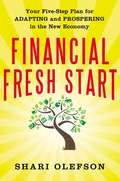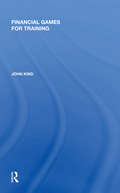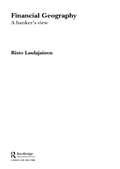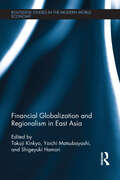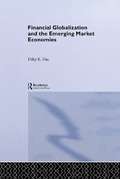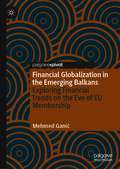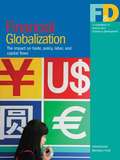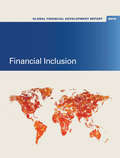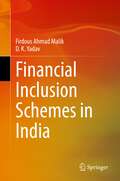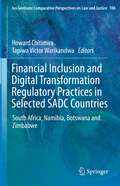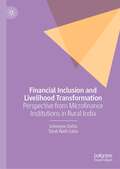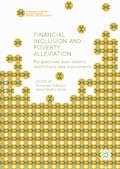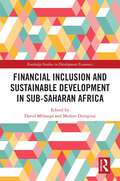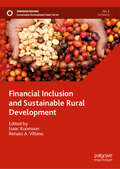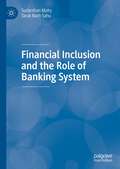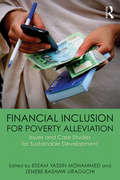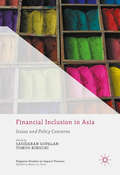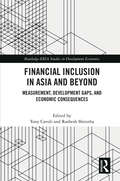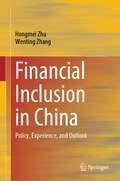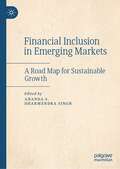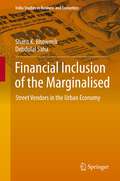- Table View
- List View
Financial Freedom on $1 a Day
by Suzanne Kirkland KincaidA financial guide useful for Parents, Senior Citizens, College Students, Educational Support Systems, Independent Politicians, Network Marketers, Small Business Owners and Charities/Non Profits.
Financial Freedom: A Proven Path to All the Money You Will Ever Need
by Vicki Robin Grant SabatierMoney is unlimited. Time is not. Become financially independent as fast as possible.In 2010, 24-year old Grant Sabatier woke up to find he had $2.26 in his bank account. Five years later, he had a net worth of over $1.25 million, and CNBC began calling him "the Millennial Millionaire." By age 30, he had reached financial independence. Along the way he uncovered that most of the accepted wisdom about money, work, and retirement is either incorrect, incomplete, or so old-school it's obsolete.Financial Freedom is a step-by-step path to make more money in less time, so you have more time for the things you love. It challenges the accepted narrative of spending decades working a traditional 9 to 5 job, pinching pennies, and finally earning the right to retirement at age 65, and instead offers readers an alternative: forget everything you've ever learned about money so that you can actually live the life you want.Sabatier offers surprising, counter-intuitive advice on topics such as how to:* Create profitable side hustles that you can turn into passive income streams or full-time businesses* Save money without giving up what makes you happy* Negotiate more out of your employer than you thought possible* Travel the world for less* Live for free--or better yet, make money on your living situation* Create a simple, money-making portfolio that only needs minor adjustments* Think creatively--there are so many ways to make money, but we don't see them.But most importantly, Sabatier highlights that, while one's ability to make money is limitless, one's time is not. There's also a limit to how much you can save, but not to how much money you can make. No one should spend precious years working at a job they dislike or worrying about how to make ends meet. Perhaps the biggest surprise: You need less money to "retire" at age 30 than you do at age 65.Financial Freedom is not merely a laundry list of advice to follow to get rich quick--it's a practical roadmap to living life on one's own terms, as soon as possible.
Financial Fresh Start: Your Five-Step Plan for Adapting and Prospering in the New Economy
by Shari OlefsonFrom depleted retirement accounts to underwater homes, its been gloomy news for years. But the picture will get much brighter for those who take advantage of the laws and reforms enacted in the wake of the banking, real estate, and economic meltdown. The Dodd-Frank Act. The Making Home Affordable Program. The Consumer Financial Protection Bureau. These are just a few examples of the significant but little-understood changes that offer people an unprecedented chance to set things right with their credit, savings and investments, employment, housing, retirement and more. Financial Fresh Start explains it all simplifying the complicated reforms and motivating readers to shake off their malaise and radically improve their long-term financial prospects. Written by a dynamic author with a unique blend of legal, financial, and real estate expertise, the books big-picture lens spans the spectrum of money matters, and delivers clear, actionable answers to questions such as: How can you repair your credit quickly and avoid high finance costs? What are the safest places for saving and investing? Can you legally avoid repaying what you owe? Will your home ever be worth what you paid for it? Is there life after foreclosure? Are you missing out on programs that can put money in your pockets? Is it possible to make up for recent losses and still retire on time? And more Big corporations and the mega-wealthy have professionals to keep them abreast of the latest regulations. Now, everyday people can learn what the new rules really mean to them with the expert guidance and practical solutions in Financial Fresh Start.
Financial Games for Training
by John KindAccounting and finance have a reputation for complexity and dullness. Financial Games for Training aims to change these perceptions! It is an original collection of more than 65 brainteasers, crosswords, puzzles and quizzes plus all the solutions. They've been specially designed to bring a light-hearted but rigorous approach to the study and teaching of an otherwise 'boring' subject. Whether you're a student or executive, participant or tutor, here's the treasure chest you need to improve your grasp of finance for business. You won't think about the subject in quite the same way ever again!
Financial Geography: A Banker's View (Routledge International Studies In Money And Banking Ser. #Vol. 25)
by Risto LaulajainenThis truly internationally-focused book is a readable, comprehensive guide to the economic geography of the world's financial centres that is as enjoyable to read as it is informative. All students and academics involved with economic geography as well as professionals in the banking and finance industries will find Financial Geography to be an ind
Financial Globalization and Regionalism in East Asia: Financial Globalization And Regionalism In East Asia (Routledge Studies in the Modern World Economy)
by Shigeyuki Hamori Takuji Kinkyo Yoichi MatsubayashiWith increased resilience in the financial systems, emerging Asian economies were less affected by the recent global financial crisis, recovering more quickly from the crisis than major advanced economies. Yet, Asian financial systems remain underdeveloped. More open and efficient financial systems continue to be a key priority for Asia’s development strategy. Emerging Asian economies need to tackle the new challenges to macroeconomic and financial stability posed by financial globalisation. This book identifies the key challenges to Asia’s financial development in an era of rapid financial globalisation and discusses their policy implications for financial reforms and regional cooperation in East Asia. Particular areas of focus include: the impact of financial globalisation on economic stability and inequality in East Asian economies; the progress of Asia’s regional financial cooperation and lessons from the recent European economic crisis; and the priority of financial reforms in individual Asian economies. Combining advanced econometric methods and in-depth case studies, this book provides rigorous and contextual analyses of the most critical issues for Asia’s financial development. It offers a comprehensive and useful guide for students, academics, and policymakers interested in the current state and future prospects of Asian financial systems.
Financial Globalization and the Emerging Market Economy (Routledge Studies In The Modern World Economy Ser. #Vol. 45)
by Dilip K. DasThe whirlwind of financial globalization has descended upon emerging market economies and rapid change has brought both benefits and problems upon a dynamic group of nations.This book examines the impact of ever increasing financial globalization on emerging market economies, both in the former communist countries of Eastern Europe and the developi
Financial Globalization in the Emerging Balkans: Exploring Financial Trends on the Eve of EU Membership
by Mehmed GanićThis book explores financial trends in the age of financial globalization and explores the changing roles within the global financial industry. At the same time, the book provides a solid foundation for understanding the dramatic process of financial globalization specifically in the emerging Balkans. More elaborately, the book examines financial trends and developments of eight countries in the emerging Balkans defined to include: Albania, B&H, Bulgaria, Croatia, Montenegro, North Macedonia, Serbia, and Romania. Building on this background, this book addresses issues related to the emerging Balkans in terms of financial development compared with the benchmark of mature economies and highlights issues related to the growing impact of financial globalization, global trade, and FDI flows. It brings the focus onto the recent trends in Intra-Balkan trade liberalization and cooperation through the transition process and on the eve of EU membership. It also assesses progress made in banking development, stock market development, and economic growth and critically examines financial trends in the emerging Balkans and changes in its financial landscape.
Financial Globalization: A compilation of articles from Finance & Development
by International Monetary FundA report from the International Monetary Fund.
Financial Inclusion
by Jim Yong KimFinancial inclusion has become a major subject of interest among policymakers, researchers, and other financial sector stakeholders. Many countries, for example, have recently adopted explicit financial inclusion strategies with targets for financial inclusion. The interest reflects an increased recognition that financial inclusion can be a driver of economic growth and poverty alleviation, and that many individuals and firms are excluded unnecessarily from even basic financial services. About half of the world's adult population-- more than 2. 5 billion people--have no bank account is one powerful example. Barriers such as cost, travel distance, and amount of paperwork and requirements play an important role. Many of these barriers can be addressed by better policies. Despite the high interest, there are still important gaps in knowledge about financial inclusion, what drives it, and what policies affect it. And while recent years have seen some increases in financial inclusion, there is still much scope to reduce barriers to access. However, one of the challenges is that efforts to increase inclusion, if not implemented well, can backfire. Deeply ingrained social problems cannot be resolved purely with an infusion of debt. If not done properly, it can have the opposite effect, making poor borrowers increasingly dependent on debt, and even contributing to financial instability. Global Financial Development Report 2014: Financial Inclusion is a new report from the World Bank Group. It takes a step back and re-examines financial inclusion from the perspective of new global datasets and new evidence. It builds on a critical mass of new research and operational work produced by World Bank Group staff as well as outside researchers and contributors. The report, the second in this series, follows up on the inaugural issue, the Global Financial Development Report 2013: Rethinking the Role of the State in Finance (http://www. worldbank. org/financialdevelopment). Accompanying the Global Financial Development Report 2014 is a vast body of underlying research and data. Among other things, this includes an expanded and updated version of the Global Financial Development Database, a dataset of over 70 financial system characteristics for 203 economies from 1960 to 2011, which is presented in the report's appendix.
Financial Inclusion Schemes in India
by Firdous Ahmad Malik D. K. YadavThe exclusion of the destitute population from the formal financial system is a long-standing problem in India. This book examines the performance of financial inclusion policies in India to understand their impact on two urban vulnerable groups, Slum Dwellers and Beggars. This study includes analysis at the national level, the variables of the financial inclusion index like Penetration, Availability, and Usage from 2006 to 2020 from the world bank data set. Similarly, the authors examine five policies on financial inclusion by conducting a primary level survey on two urban capital cities of Lucknow and Kolkata, using a well-structured questionnaire for data collection. The authors uses two sampling techniques: simple random in the case of beggars, and stratified random in the case of slum dwellers.This book highlights the difference between financial access and non-access of household respondents in capturing the impacts of financial inclusion schemes on their socio-economic condition and financial behavior. The findings indicate that access to these schemes is extremely limited for the underprivileged population, such as beggars and slum dwellers. The analysis has shown that claims made by the government are not based on real-life occurrences. This book demonstrates that these programs have a negligible effect on life-deprived people.This book will be of interest to academia, policymakers, and society at large.
Financial Inclusion and Digital Transformation Regulatory Practices in Selected SADC Countries: South Africa, Namibia, Botswana and Zimbabwe (Ius Gentium: Comparative Perspectives on Law and Justice #106)
by Howard Chitimira Tapiwa Victor WarikandwaThis book investigates the regulation and promotion of financial inclusion and provides a comparative analysis of the regulation, promotion and enforcement of the relevant laws in the SADC (in particular, South Africa, Namibia, Botswana and Zimbabwe), as well as the challenges of financial inclusion. In turn, it evaluates financial inclusion in the context of specific challenges faced by unbanked and underbanked customers, who are easy targets for cyber criminals because they tend to have lower levels of digital literacy. The book presents novel discussions that identify the challenges and flaws associated with the enforcement of financial inclusion laws and related measures intended to promote financial inclusion in the SADC region. This is primarily done in order to reveal the current strengths and weaknesses of financial inclusion laws in relation to certain aspects of the companies, securities and financial markets in the region. For example, there is no common financial inclusion instrument/law that is effectively and uniformly applied throughout the SADC. This has impeded the enforcement authorities’ efforts to effectively combat financial exclusion across the region.The book is likely the most comprehensive study to date on the regulation and promotion of financial inclusion in the SADC region and fills a major gap in SADC and African legal jurisprudence. As such, it offers a valuable asset for policymakers, attorneys, bankers, securities (share) holders, and other market participants who deal with financial inclusion, as well as undergraduate and graduate students interested in the topic.
Financial Inclusion and Livelihood Transformation: Perspective from Microfinance Institutions in Rural India
by Tarak Nath Sahu Srimoyee DattaThis book explores the role and effect of Microfinance Institutions (MFIs) with different dimensions. It is being supported with strong empirical evidence into various parameters of MFIs directed towards inclusive finance and the transformation journey of livelihoods of its beneficiaries.It also incorporates empirical evidence with the perception of both beneficiaries and non-beneficiaries. Starting its journey toward the path of comprehending how MFIs make their footprint among the excluded population in the selected areas, it incorporates the different outcomes of MFI lending like credit utilisation patterns, income generation, and employability. As financial stability helps to break out the vicious cycle of poverty, this book emphasises the self-dependent element for the beneficiaries and their households. It addresses the important issue of the female counterparts in society. It shows how the MFIs work actively to generate female empowerment from multiple dimensions among the selected communities. It addresses key issues to consider for inclusive policy formulation, especially for backward communities in the backward areas and gives a realistic scenario of the MFI activities, their interactions with the respondents, the various outcomes, and areas for further developments, etc. This book is beneficial for academicians, researchers, and policymakers.
Financial Inclusion and Poverty Alleviation: Perspectives from Islamic Institutions and Instruments (Palgrave Studies in Islamic Banking, Finance, and Economics)
by Muhamed Zulkhibri Abdul Ghafar IsmailThis book explores the relationships between financial inclusion, poverty and inclusive development from Islamic perspectives. Financial inclusion has become an important global agenda and priority for policymakers and regulators in many Muslim countries for sustainable long-term economic growth. It has also become an integral part of many development institutions and multilateral development banks in efforts to promote inclusive growth. Many studies in economic development and poverty reduction suggest that financial inclusion matters. Financial inclusion, within the broader context of inclusive development, is viewed as an important means to tackle poverty and inequality and to address the sustainable development goals (SDGs). This book contributes to the literature on these topics and will be of interest to researchers and academics interested in Islamic finance and financial inclusion.
Financial Inclusion and Sustainable Development in Sub-Saharan Africa (Routledge Studies in Development Economics)
by David Mhlanga Mufaro DzingiraiThis book delves into the transformative power of the Fourth Industrial Revolution (4IR) in reshaping the landscape of sustainable development in one of the world's most vibrant regions. This edited volume explores the synergy between cutting-edge digital technologies and innovative financial strategies to drive responsible business practices that align with the Sustainable Development Goals (SDGs).This book navigates the complex interplay between technological advancements, financial inclusion, corporate social responsibility, environmental stewardship, and ethical governance. It critically assesses how digital innovations—ranging from artificial intelligence, blockchain, and the Internet of Things (IoT) to green technologies and fintech—alongside novel financial instruments such as green bonds and impact investing, can address key concerns such as poverty alleviation, gender parity, and environmental sustainability. With a wide range of expert contributions, this volume offers useful insights and practical solutions to promote financial inclusion and encourage sustainable growth in Sub-Saharan Africa. It achieves this through a combination of empirical research, case studies, and policy analysis.This resource is crucial for policymakers, scholars, and development practitioners who are dedicated to advancing inclusive and sustainable development.
Financial Inclusion and Sustainable Rural Development (Sustainable Development Goals Series)
by Isaac Koomson Renato A. VillanoThis book compiles topics on how financial inclusion, from either unidimensional or multidimensional perspectives, can be used as a viable policy tool to achieve sustainable development goals (SDGs) in rural/regional areas. Part I of the book sets the scene by providing a thematic overview of the SDGs and the theoretical link between financial inclusion and SDGs from the rural perspective. Parts II to VI present several empirical studies/chapters that explore the impact of financial inclusion on specific goals and targets of the SDGs in rural areas across various regions/continents. Part VII draws on the findings from Parts I and VI to provide a discourse on the viability of financial inclusion as an effective policy for achieving the SDGs in rural areas across the globe.
Financial Inclusion and the Role of Banking System
by Tarak Nath Sahu Sudarshan MaityThe book portrays the scope and dimension of different financial inclusion strategies. It looks at the role and potential of banks involved in financial inclusion. This book focuses on the importance of financial inclusion and in measuring its important determinants. It provides an empirical insight into how the different factors influence financial inclusion of a nation, providing a guideline to the banks and the regulators to select an effective structure of bank branch and efficient composition, to ensure best utilization of their devoted resources in the context of a developing economy.
Financial Inclusion at Omidyar Network
by Vikram Gandhi James Barnett Caitlin Lindsay Reimers BrummeA team of investors at Omidyar Network explore two different investment possibilities in the budding financial inclusion space, using their investment framework to consider capital alternatives available for both investments, each of which carries highly divergent financial and impact potential.
Financial Inclusion for Poverty Alleviation: Issues and Case Studies for Sustainable Development
by Essam Mohammed Zenebe UraguchiMore than one billion people still live below the poverty line – most of them in South Asia and Sub-Saharan Africa. Financial inclusion is a major issue, as more than three-quarters of the numbers of poor and disadvantaged women and men do not have access to financial products and services, such as bank accounts, affordable and suitable loans, and insurance. The key objective of this book is to provide practical case studies of financial inclusion, rather than focus on academic debates such as the ideological basis of promoting microfinance. Using the recently adopted Sustainable Development Goals as an overall framing of the issues, it shows how poor and disadvantaged women and men can be bankable if the right facilitation for maximizing opportunities and addressing constraints are in place. Case studies confirm that achieving inclusive and sustainable access to financial products and services goes beyond simply enabling poor and disadvantaged women and men to have access to credit, or the ability to open a bank account. Examples from Africa, Asia and Latin America demonstrate encouraging progress in making microcredit accessible to millions of poor people. The foremost challenge, however, has been to ensure that they have access to, and usage intensity of, suitable and affordable financial products and services that meet the needs of their livelihoods as well as risks and mitigation strategies. This requires understanding that poor and disadvantaged women and men do not exist in isolation from complex and interdependent functions in the financial system, which includes a number of actors, diversified services, constraints (not just symptoms) and capacities and incentives. Overall, the book provides a rich source of examples of how building inclusive financial systems can empower the world's poor – by increasing income and employment opportunities, securing livelihoods and reducing poverty.
Financial Inclusion in Asia
by Sasidaran Gopalan Tomoo KikuchiThis book brings together a set of analytical and empirical essays aimedat understanding inclusive finance in emerging markets focusing on Asia. Despite the significant policy interest in the issue of financial inclusion inthe Asian market, there is a dearth of academic literature on the topic. Thisbook fills this gap by being the first of its kind to address the relevantissues and policy concerns relating to the availability and affordability offinancial services in this rapidly emerging geopolitical area. The bookfeatures a mixture of empirical and case study oriented essays, informed bydata, literature and policy analysis that will be useful for both the academicsand the policy makers in the region interested in the subject. Countrieshighlighted in the essays assessing financial inclusivity include Indonesia,Sri Lanka and India.
Financial Inclusion in Asia and Beyond: Measurement, Development Gaps, and Economic Consequences (Routledge-ERIA Studies in Development Economics)
by Tony CavoliThe World Bank considers financial inclusion to be an enabler for at least 7 of the 17 United Nation’s sustainable development goals (SDGs). Financial inclusion, with its associated policy implications, is an important issue for ASEAN. This book examines the economic effects of financial inclusion. It explores issues surrounding measurement and impact of financial inclusion. The book looks at various, salient topics including measurement of financial inclusion, the impact of (various indicators of) financial inclusion on development outcomes and macroeconomic volatility using aggregate data, as well as the effects of financial inclusion on poverty and development outcomes using micro data.
Financial Inclusion in China: Policy, Experience, and Outlook
by Hongmei Zhu Wenting ZhangThis book aims to provide first-hand information for readers who are concerned about inclusive finance and sustainable development by summarizing China’s policy measures and practical innovations in the development of inclusive finance and expects to provide China’s experience for the development of inclusive finance in more regions. From a worldwide perspective, a large number of people had been excluded from formal financial services for a long time due to various factors. Even in developed economies with sound financial systems, relatively disadvantaged groups are often denied access to effective financial services. In 2005, the United Nations proposed the concept of Inclusive Finance, emphasizing the extension of financial services to less developed regions and low-income groups in society at an affordable cost by improving financial infrastructure and providing them with reasonably priced and convenient financial services. In 2015, the United Nations adopted the 2030 Agenda for Sustainable Development, making inclusive finance an important focus for achieving sustainable development. It has become a global consensus to vigorously develop inclusive finance. China has attached importance to improving financial services for disadvantaged groups such as rural residents, micro-, small and medium enterprises (MSMEs) and others. In 2013, Developing “Inclusive Finance” became China’s national strategy. In 2015, China formulated the Plan for Promoting the Development of Inclusive Finance (2016-2020). In 2016, during its presidency of the Global Partnership for Financial Inclusion (GPFI), China proposed the issue of "Digital Financial Inclusion" and issued the G20 High-level Principles for Digital Financial Inclusion at the G20 Hangzhou Summit in the same year. Through policy guidance and active practice by the financial sector, China has gradually formed a unique development model of inclusive finance and achieved remarkable successes. Physical outlets, service machines and online service channels have been improved, and basic financial services have generally covered both urban and rural areas. The financial services for rural households and MSMEs have improved significantly. The efficiency and convenience of financial services have been significantly improved, and the satisfaction of financial services has significantly increased. China's experience in inclusive finance has been recognized by the international community. In 2017, five cases from China were selected in the G20 report on Digital Financial Inclusion: Emerging Policy Approaches.
Financial Inclusion in Emerging Markets: A Road Map for Sustainable Growth
by Ananda S. Dharmendra SinghThis book discusses ideas for stakeholders to develop strategies to access and use financial products and services such as deposits, loans, and fund transfer mechanism, insurance, payment services, and intermediaries, distribution channels at economical prices in order to cater to the needs of the poor and underprivileged people. Financial inclusion ensures ease of access, availability, and usage of the financial products and services to all the sections of the society. The book will help in recognizing the role of financial inclusion as one of the main drivers in reducing income inequality and thus supporting sustainable economic growth of the countries, especially of an emerging economy. The book provides conceptual and practical ideas from the practitioners, best practices from the experts, and empirical views from the researchers on the best practices and how to mitigate the challenges and issues plaguing the development of the financial inclusion.
Financial Inclusion of the Marginalised: Street Vendors in the Urban Economy
by Debdulal Saha Sharit K. BhowmikThis book is the product of a study conducted by the Tata Institute of Social Sciences (TISS) in collaboration with the United Nations Development Programme (UNDP) and Ministry of Urban Housing and Poverty Alleviation (MoHUPA). Its objective is to highlight some of the problems faced by street vendors in conducting their daily business and to examine how financial institutions, especially those in the banking sector, can include street vendors in their credit policies. Data was collected from 15 cities across the country. Not surprisingly, while issues such as public space utilisation have been deliberated upon at length, those concerning the nature of credit transactions and concurrently the financial inclusion of street vendors have scarcely received focussed attention. In the absence of formal credit, street vendors largely depend on loan sharks, who charge high interest rates ranging from 350% to 800% per annum. The problem of formal credit aside, another equally important factor is the inflexible attitude of the civic authorities towards street vending. Given their informal status, this is particularly apparent because they are forced to conduct business in the absence of legal protection, making them vulnerable to rent seeking by the authorities. The acceptance of the National Policy for Urban Street Vendors by a few states and the subsequent bill to protect the livelihood of street vendors should help them gain legitimacy and subsequently credit to run their businesses at proper rates. The book examines and analyses these issues.


